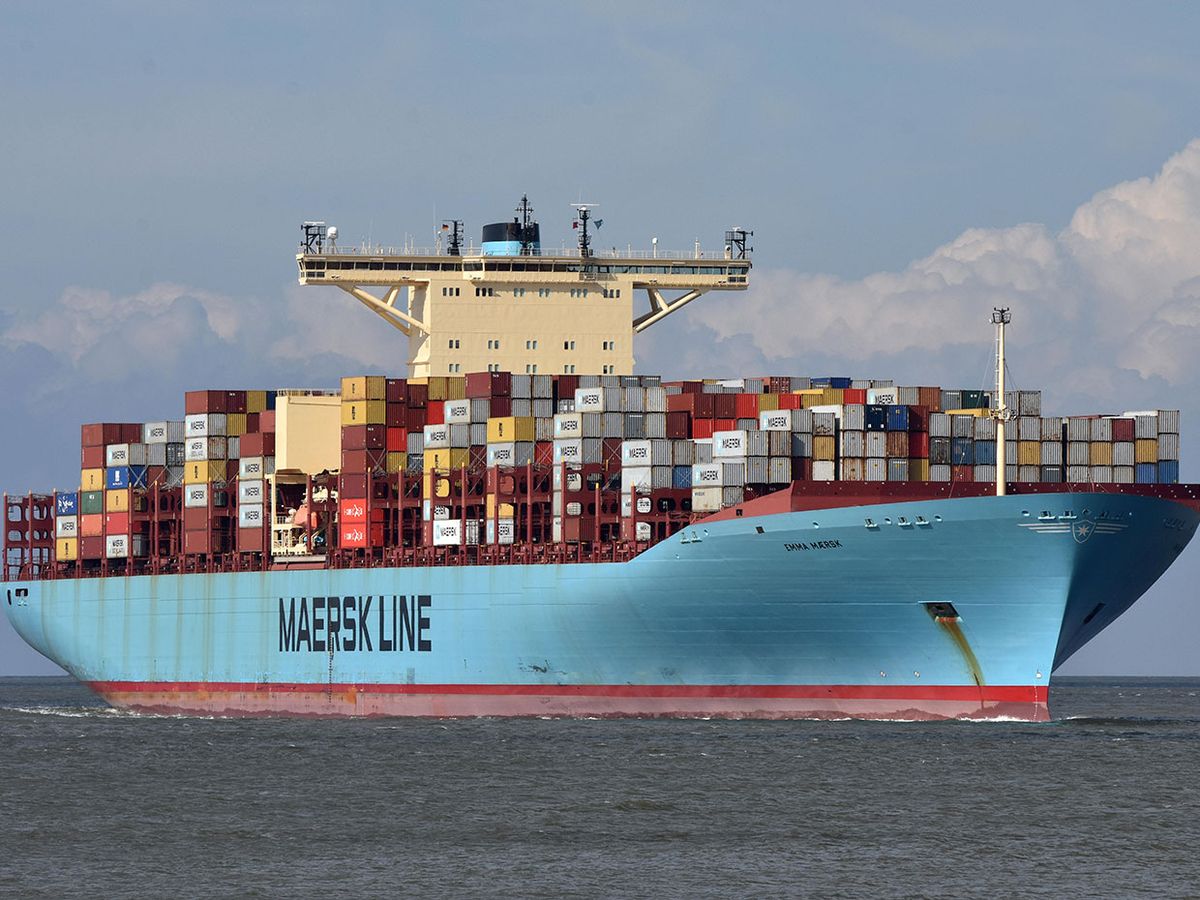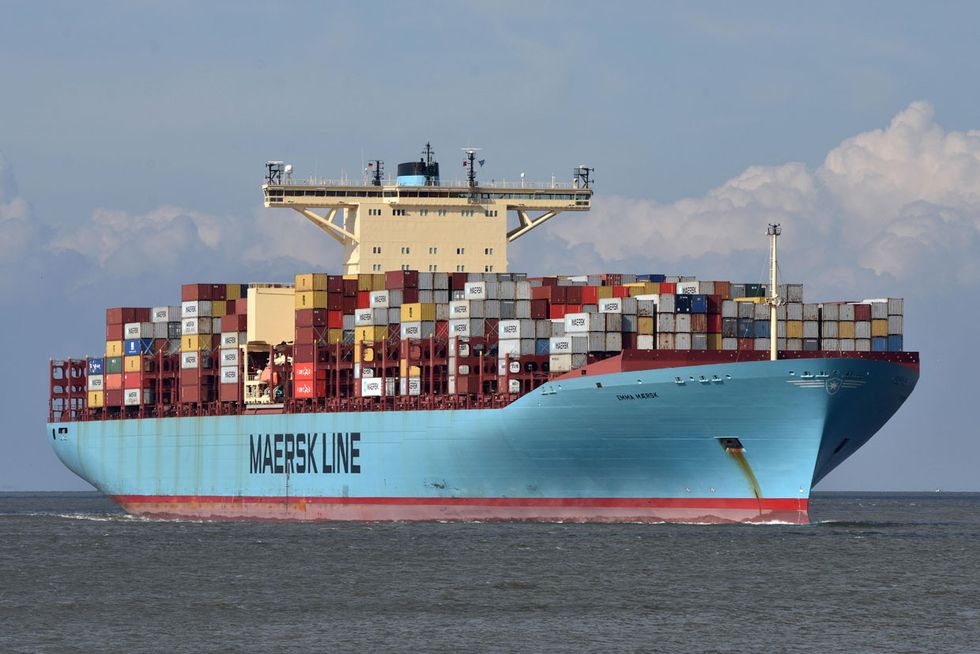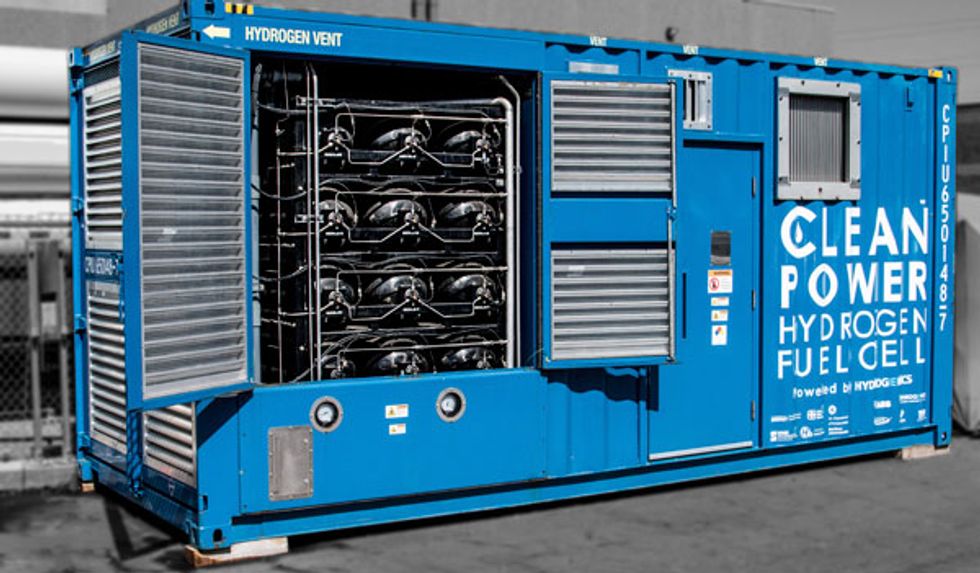The Struggle to Make Diesel-Guzzling Cargo Ships Greener
How these emission-belching behemoths will transition to batteries and fuel cells


Jump to Articles in this Section
At the pier outside Amsterdam’s central train station, commuters stride aboard the IJveer 61. The squat ferry crisscrosses the waterfront, taking passengers from the city’s historic center to the borough of Noord. Beneath their feet, two electric motors propel the ferry through the gray-green waters, powered by 26 lithium-ion polymer batteries and a pair of diesel generators.
Hybrid vessels like theIJveer 61 are increasingly common in the Netherlands, where officials are pushing to limit toxic air pollution and reduce greenhouse gas emissions from the maritime sector. Patrol vessels and work ships are turning more to batteries and using less petroleum-based fuel; so are crane-carrying boats that pluck fallen bicycles from Amsterdam’s famous canals.
Some of these vessels recharge during off-hours, pulling from the harbor’s electric grid connection. In other boats, diesel generators recharge batteries as they run. As the harbor’s electricity infrastructure expands, more vessels could ditch diesel entirely, says Walter van der Pennen from EST-Floattech, the Dutch energy-storage company that oversaw installation of the IJveer 61’s series hybrid system.
“The next step is to move away from hybrids,” he tells me one drizzly afternoon from a café overlooking the waterway. “For all of the vessels here, it’s perfectly suitable to go full electric.”
Meanwhile, at a nearby shipyard, another company is building what it dubs the “Tesla ship”—an all-electric river barge, like a Model 3 for the sea. Its makers at Dutch manufacturer Port-Liner expect to complete five small barges and two large barges this year to edge out the area’s diesel-burning, soot-spewing versions.
These Dutch vessels mark the beginnings of a much larger energy transformation sweeping the world’s maritime shipping industry. As emissions climb and environmental policies strengthen, shipping companies and engineers are accelerating their pursuit of so-called zero-emissions technologies—a category that includes massive battery packs and fuel cells that run on hydrogen or ammonia. Hundreds of large cargo ships are also switching to liquefied natural gas, which produces less toxic air pollution than the typical maritime “bunker fuel” and is widely considered a stepping-stone on the path to full decarbonization.
“It’s been a journey for the shipping industry, but there’s now a broad understanding and agreement that there is a need to do something” about climate change, says Katharine Palmer, global sustainability manager at the shipping services company Lloyd’s Register. “Now it’s a case of working out what that ‘something’ is.”
Unlike vehicles and power plants, cargo ships remain conveniently out of sight to most of us. Yet shipping is the linchpin of our modern economy, moving about 90 percent of all globally traded goods, including T-shirts, bananas, and smartphones along with medicine, fuel, and even livestock. Around 93,000 container ships, oil tankers, bulk carriers, and other vessels now ply the world’s waterways, delivering some 10.3 billion metric tons of goods in 2016, according to United Nations trade statistics. That’s four times the cargo delivered in 1970.
Nearly all cargo ships use diesel combustion engines to turn the propellers, plus diesel generators that power onboard lighting systems and communications equipment. Many vessels still burn heavy bunker fuel, a viscous, carbon-intensive petroleum product that’s left from the crude oil refining process.
As a result, maritime shipping contributes a sizable share—about 2 to 3 percent—of annual carbon dioxide emissions, according to the International Maritime Organization (IMO), the U.N. body that regulates the industry. Left unchecked, however, that share could soar to 17 percent of global carbon emissions by 2050 as trade increases and other industries curtail their carbon footprints, the European Parliament [PDF] found in a 2015 report.
With pressure mounting to tackle climate change, the IMO has taken steps to limit emissions, including requiring newly constructed ships to meet energy efficiency guidelines. In April, regulators adopted a landmark agreement to reduce greenhouse gas emissions from shipping by at least 50 percent by 2050 from 2008 levels. Yet to align with the Paris climate agreement’s goals of keeping global warming to “well below” 2 °C above preindustrial levels, the industry must go even further, slashing its emissions to zero by midcentury. That means all vessels, from small ferries to ocean-faring cargo ships, must adopt zero-emissions systems in the coming decades, according to a research consortium comprised of major shipping companies and academic institutes.
Many shipbuilders and owners still aren’t convinced that such an overhaul is possible. But Palmer and other researchers say the technologies already exist to achieve this clean-shipping transformation. The challenge now, she says, is “making those technologies economically feasible, as well as being able to scale them.”
To get a glimpse of shipping’s future, I visited Hydrogenics, one of the world’s largest hydrogen producers and fuel cell manufacturers, at its headquarters near Toronto.
Among shipping experts, hydrogen fuel cells are considered the front-runner for zero-emissions technologies on larger, long-distance ships. Briefly, fuel cells get their charge not by plugging into the wall, as batteries do, but from hydrogen. With onboard hydrogen storage, fuel cells can produce power for the duration of most trips. Today’s batteries, by contrast, can’t make it very far without stopping to charge—and that’s impossible if a ship is in the middle of the ocean.
Cargo ships are “just too power hungry, and the run times are too large,” Ryan Sookhoo, Hydrogenics’ director of business development, tells me. “When we look at the marine space, we see it as a natural adopter [of fuel cells]. There’s only certain technologies that will be able to deliver.”
Hydrogenics has installed its fuel cells in buses, trains, cars, a four-seater airplane, speedboats, and a research vessel in Turkey. In recent years, the company has partnered with the U.S. energy and transportation departments and Sandia National Laboratories to build and test a fuel cell system that could eventually propel a cargo ship.
Sookhoo leads me through the company’s cavernous research and development wing, out a back door, and into the rain. A bright-blue 20-foot shipping container sits in the parking lot, labeled “Clean Power” in white block letters.

We step inside. In a back corner, four 30-kilowatt fuel cell modules are stacked on sliding shelves, like computer servers on a rack. Elsewhere in the container are 15 cylindrical tanks full of compressed hydrogen gas.
As it’s set up now, the blue container works as a generator. But unlike its diesel counterparts, it doesn’t emit any sulfur dioxide, nitrogen oxides, or carbon dioxide—only a little heat and water, which is vented out the container’s side like mist in a steam room.
Fuel cells have three key components: a negative post, or anode; a positive post, or cathode; and a polymer electrolyte membrane, an extremely thin material that resembles plastic kitchen wrap. Hydrogen gas arrives at the anode, where the molecules break down into positively charged ions and negatively charged electrons. The membrane allows the positive ions to pass through it into an electrolyte and thence to the cathode; the electrons flow from the anode through an outside circuit, producing current. Finally, at the cathode, the electrons returning from the circuit reunite with the hydrogen ions coming from the anode and, together with oxygen from the air, they form water.
In the container, the electricity produced by the fuel cell flows to a separate rack of power inverters, which change the direct current power to alternating current. That electricity then goes into a transformer, shaped like a chest freezer, and then over to a dozen power outlets on the external wall. A suitcase-size battery, charged by the fuel cell, runs the fans that cool the container and vent any hydrogen that leaks from the tanks.
Before returning to Canada, where the unit was built, this fuel cell system was tested in the Port of Honolulu. The Hawaiian shipping company Young Brothers used it to power refrigerated containers on shore. Eventually, Sookhoo says, Hydrogenics and Sandia plan to assemble these components inside a ship’s engine room to run electric motors that drive the propellers.
About two dozen early projects have shown that fuel cells are technically capable of powering and propelling vessels. The most prominent among them is the Viking Lady, a supply vessel for offshore rigs that launched in Copenhagen in 2009. Its molten carbonate fuel cell, with a power output of 330 kW, uses liquefied natural gas in lieu of hydrogen.
Wärtsilä Corp., the Finnish manufacturer that installed the Viking Lady’s hybrid system, has said its chief challenge was establishing industry-approved technical standards and safety procedures for the first-of-its-kind installation. (Separately, ExxonMobil is testing whether molten carbonate fuel cells could generate electricity from power plant emissions.)
While maritime fuel cells haven’t yet been deployed on a large, commercial scale, a recent Sandia study [PDF] suggests that oceangoing ships could feasibly operate using existing hydrogen fuel cell technologies. For instance, researchers studied the Emma Maersk, a mega–container ship with an 81-MW diesel propulsion engine that routinely travels some 5,000 nautical miles (about 9,000 kilometers) from Malaysia to Egypt. Based on the available volume and mass of the ship’s engine and fuel rooms, they found the vessel could support enough fuel cell modules and hydrogen tanks to complete one of these long-distance trips before needing to refuel—on paper, at least.
Joseph W. Pratt, who coauthored the study, says he had expected to find that fuel cell systems simply wouldn’t work on bigger ships or on longer voyages. He thought that as the ship scaled up, the amount of required fuel cells, tanks, and storage equipment would become too heavy, or too voluminous, to fit within the vessel.
“The biggest surprise was that there wasn’t a limit,” Pratt recalls from San Francisco, where he recently founded Golden Gate Zero Emission Marine to provide fuel cell power systems and fueling logistics.
His team also studied batteries, which proved the better option for high-power vessels making short trips, such as ferries or yachts. If ships can recharge at point A and again at point B, they don’t need to carry hydrogen storage tanks, which saves space and weight. And batteries are less expensive than fuel cells.
The hybrid carries passengers and cars around Amsterdam along with its sister ferry, the IJveer 61. Photo: EST-Floattach





Sookhoo says future zero-emissions cargo ships will likely use both technologies. Batteries can provide the initial spike of electricity that fires up the electric motor and puts the ship in motion—much as a car battery functions—while fuel cells will serve as the “range extender” that takes over as the battery winds down.
Given the potential, why aren’t more cargo shipbuilders ditching diesel and switching to fuel cells?
The technology is still prohibitively expensive, because fuel cells aren’t yet mass-produced. On a dollar-per-kilowatt-hour basis, the electricity cost from a fuel cell is roughly double or triple that from a diesel generator, Sookhoo estimates.
Second, hydrogen refueling stations are scarce and unevenly distributed around the world, whereas bunker fuel remains cheap and ubiquitous. For fuel-cell-powered freighters to succeed, ports will need to pipe in and store more hydrogen, and hydrogen production must ramp up dramatically.
Nearly all hydrogen produced today is made using an industrial process called steam-methane reforming, which causes the methane in natural gas to react with steam to create hydrogen and carbon dioxide. However, because natural-gas production and use results in greenhouse gases—methane itself is such a gas—the best way to make hydrogen for clean transportation is through electrolysis.
That process involves splitting water into hydrogen and oxygen by using electricity, ideally from renewable sources such as wind and solar power. Electrolysis facilities are growing in number, particularly within renewables-rich Europe, but not yet at the rate needed to supply tens of thousands of ships.
Finally, maritime authorities are only now starting to finalize the safety codes and design standards that will govern how fuel cell ships and fueling stations are built. Pilot projects can quickly adapt to rule changes, but large multimillion-dollar constructions cannot. This regulatory limbo also feeds into the wariness that many shipping companies and port operators feel about hydrogen as a fuel source.

Smil Says…
No-fuel megaships would need what we do not have as yet: megabatteries or mega–fuel cells.
Click here for Vaclav Smil”s commentary on the entire Blueprints for a Miracle special report.
For many people, the word “hydrogen” still evokes visions of the Hindenburg, a hydrogen airship that burst into flames in 1937 when hydrogen technology was still in its infancy. “Everyone references it,” Sookhoo says, with a hint of frustration. Modern hydrogen systems, however, are equipped with ventilators, sensors, and automatic shutdown modes to prevent flammable gas from building up and exploding.
However, one segment of the shipping world is readily embracing fuel cells: cruise lines, which face stronger air quality restrictions than other maritime companies. Many cruise ships and ferries don’t use diesel combustion engines. Instead, they have “diesel-electric” power trains. A diesel engine drives an electric generator, which in turn powers large electric motors. Because this platform and fuel cells are both rooted in electricity—not combustion—the new technology can more easily integrate into existing cruise ship designs.
Last fall, Viking Cruises announced plans to build a 900-passenger vessel in Norway that will use fuel cells running on liquid hydrogen for its main propulsion. A competitor, Royal Caribbean Cruises, is installing a fuel cell on a new vessel to supply onboard electricity while stationed in ports, with a longer-term vision of using fuel cells for propulsion.
While fuel cells are early on the adoption curve, battery-powered ships are steadily multiplying, particularly in Norway.
The Scandinavian country has deep pockets to invest in new maritime technologies, thanks to both its sovereign oil fund—which topped US $1 trillion last year—and a tax on ships’ emissions of nitrogen oxides, which are potent greenhouse gases and key ingredients in acid rain. The region also has an abundance of hydropower, which can support more battery-charging stations and hydrogen-production facilities.
Norway’s government plans to have 60 all-electric ferries in its fjords within three years, a target it set following the 2015 launch of MS Ampere, the first midsize commercial ferry to operate fully on battery power.
The Ampere carries 10 metric tons of lithium-ion batteries to power two electric motors, each with an output of 450 kW. The ferry fully recharges its batteries overnight but tops off every time it docks, for a period of about 10 minutes.
During trials, this fast-charging system repeatedly disrupted service on the rather small local electric grid. Siemens, which designed the charging infrastructure, fixed the problem by placing a high-capacity lithium-ion battery at each pier, enabling the Ampere to quickly recharge from the battery, while the battery gradually recharged from the grid.
The Ampere was a turning point for battery-powered shipping, says Jostein Bogen, the global product manager for energy storage systems in ABB’s marine and ports division. “The big start came from Norway, but now we see it coming all over the world,” he says from his office in Oslo, citing ABB’s electric ship projects in China, Turkey, and across Europe.
ABB recently converted two diesel ferries, the Tycho Brahe and the Aurora, into the world’s largest battery-driven ferries. The vessels, which connect Denmark and Sweden via the Øresund strait, each carry batteries that can deliver 4.16 MW of power and have a combined storage capacity of 8,320 kWh—equivalent to 10,700 car batteries. The ferries will quickly recharge at automated shore-side stations.
That project hit a snag in mid-2017, when it experienced a technical challenge in connecting and disconnecting the charging cables from the vessel, under certain conditions. The automated system had been tested successfully in a simulated factory environment, but it needed additional testing to make sure it could operate reliably in the real world, ABB said.
After postponing the Tycho Brahe’s launch, the ship operator HH Ferries began sailing the ferry in late 2017 in both full-battery and hybrid modes. ABB said it continues to make adjustments to the charging procedures.
As for container ships, tankers, and bulk carriers—the biggest contributors to the shipping industry’s carbon footprint—zero-emissions technologies may still be years away. But early projects with ferries and cruise ships could help convince shipbuilders and operators that fuel cells, batteries, and other technologies are viable alternatives—particularly where there is access to low-cost energy sources, or where ship operators can pass on additional costs associated with each voyage to their supply chain.
“Niche sectors have the ability to do this and drive the innovation,” says Palmer of Lloyd’s Register.